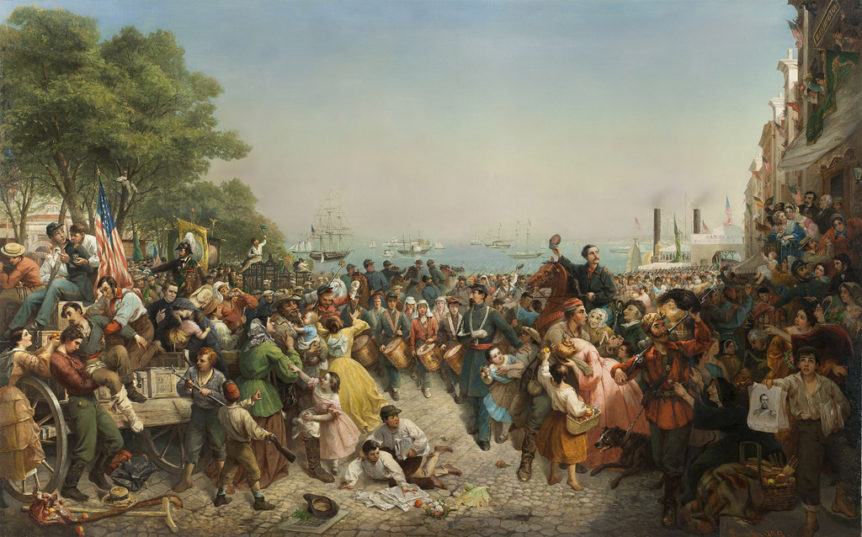There is an excellent reason why we no longer hang paintings as they have now done in an odd but worthy exhibition at the New-York Historical Society. Indeed, even at the N-YHS, that hanging would be inexcusable, were it not for the fact that the whole point of The Works: Salon Style at the New-York Historical Society, (on view through February 8, 2015) is to recreate the museum experience of nineteenth-century New York.
“Salon Style” refers to a way of exhibiting paintings that was common in the Salons of the 18th and 19th Centuries and that is antithetical to all the ingrained habits of modern museology. Rather than allowing the sacred object to be contemplated in isolation and at eye level, where its virtues can be best appreciated, the Salon Style stacks them up all the way to the ceiling.
In the great central gallery on the second floor of the New York Historical Society, that ceiling is about twenty feet high and the paintings are stacked in rows of three. What results is a crazy quilt of paintings, ranging from Dutch landscapes of the 17th Century-from New Amsterdam, after all-to street scenes from the 1920s. And yet, as the museum’s director, Brian T. Allen, writes in a statement that accompanies the exhibition, “There is some method to the madness of these displays….I have decided to put the largest things first. Once that happens, many of the other groupings develop naturally.”
The groupings include family portraits, landscapes and presidential portraits. As though going back in time, one savors the quaint pietism of Jacob’s Dream, by Luther Terry in 1852, as well as the sentimental genre scene, The Cavalier’s Return, by Richard Caton Woodville. Better known, and more often on view at the NYHS, are the works of Thomas Cole and Asher B. Durand, the two founders of the Hudson River School.
One of the biggest and most ambitious works-which hangs by itself-is Louis Lang’s “Return of the 69th (Irish) Regiment, N.Y.S.M. from the Seat of War” (c. 1863). As the mounted captain in the center of the composition raises his hat in salutation, the multitudes rejoice like the chorus and supernumeraries in an over-the-top production of Aida. As with so many 19th Century academic works, this is not an especially good painting, and yet, like so many such works, it is delightful in its way. Much the same can be said for the display of all the paintings that now surround it.
The Works: Salon Style at the New-York Historical Society * New-York Historical Society * to February 8, 2015 * nyhistory.org


 Thomas Cole (1801- 1848), Moonlight Landscape, ca. 1833-34. Oil on canvas. New-York Historical Society, Gift of The New-York Gallery of the Fine Arts, 1858.31
Thomas Cole (1801- 1848), Moonlight Landscape, ca. 1833-34. Oil on canvas. New-York Historical Society, Gift of The New-York Gallery of the Fine Arts, 1858.31 George Whiting Flagg (1816 – 1897), Murder of the Princes, ca. 1833-34. Oil on canvas. New-York Historical Society, Gift of The New-York Gallery of the Fine Arts, 1858.48
George Whiting Flagg (1816 – 1897), Murder of the Princes, ca. 1833-34. Oil on canvas. New-York Historical Society, Gift of The New-York Gallery of the Fine Arts, 1858.48 George Whiting Flagg (1816 – 1897), Murder of the Princes, ca. 1833-34. Oil on canvas. New-York Historical Society, Gift of The New-York Gallery of the Fine Arts, 1858.48
George Whiting Flagg (1816 – 1897), Murder of the Princes, ca. 1833-34. Oil on canvas. New-York Historical Society, Gift of The New-York Gallery of the Fine Arts, 1858.48 Charles Willson Peale (1741-1827), The Peale Family, 1773-1809, Oil on canvas. New-York Historical Society, Gift of Thomas Jefferson Bryan, 1867.298
Charles Willson Peale (1741-1827), The Peale Family, 1773-1809, Oil on canvas. New-York Historical Society, Gift of Thomas Jefferson Bryan, 1867.298 Louis Lang (1814-1893), Return of the 69th (Irish) Regiment, N.Y.S.M. from the Seat of War, 1862. Oil on canvas. New-York Historical Society, Gift of Louis Lang, 1886.3
Louis Lang (1814-1893), Return of the 69th (Irish) Regiment, N.Y.S.M. from the Seat of War, 1862. Oil on canvas. New-York Historical Society, Gift of Louis Lang, 1886.3 Childe Hassam (1859-1935), Flags on 57th Street, Winter of 1918, 1918. Oil on canvas. New-York Historical Society, Bequest of Julia B. Engel, 1984.68
Childe Hassam (1859-1935), Flags on 57th Street, Winter of 1918, 1918. Oil on canvas. New-York Historical Society, Bequest of Julia B. Engel, 1984.68 John Singer Sargent (1856-1925), Mrs. Jacob Wendel,1888. Oil on canvas. New-York Historical Society, Gift of the Roger and Susan Hertog Charitable Fund and Jan and Warren Adelson, 2012.21
John Singer Sargent (1856-1925), Mrs. Jacob Wendel,1888. Oil on canvas. New-York Historical Society, Gift of the Roger and Susan Hertog Charitable Fund and Jan and Warren Adelson, 2012.21 Asher B. Durand (1796-1886), Woodland Brook, 1859. Oil on canvas. New-York Historical Society, The Robert L. Stuart Collection, S-190
Asher B. Durand (1796-1886), Woodland Brook, 1859. Oil on canvas. New-York Historical Society, The Robert L. Stuart Collection, S-190